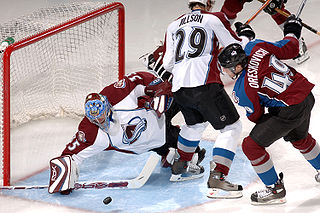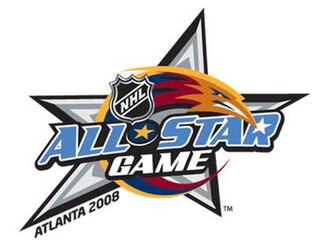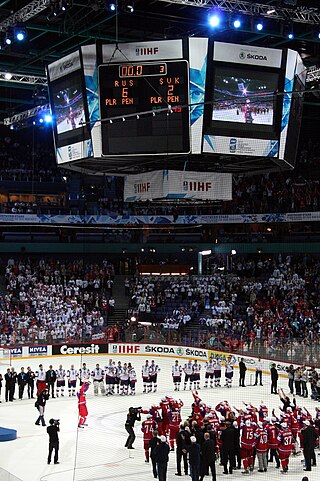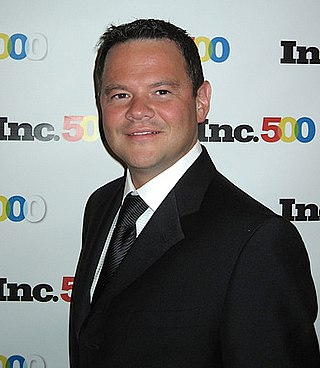This article needs additional citations for verification .(September 2020) |
A shot in ice hockey is an attempt by a player to score a goal by striking or snapping the puck with their stick in the direction of the net.
Contents

This article needs additional citations for verification .(September 2020) |
A shot in ice hockey is an attempt by a player to score a goal by striking or snapping the puck with their stick in the direction of the net.

There are five basic types of shots in ice hockey.
The shovel shot (also referred to as a flip shot) is the simplest and most basic shot in a shooter's arsenal. Its execution is simply a shoveling motion to push the puck in the desired direction, or a flick of the puck (be it on the forehand, backhand, or in a spearing motion). Players typically resort to shoveling the puck to push loose pucks past a sprawling, or out-of-position goaltender.
The wrist shot is executed by positioning the puck toward the heel-middle of the blade. From that position the shooter rolls their back wrist quickly, while thrusting the puck forward with the bottom hand. As the blade propels the puck forward the movement of the wrist rolls the puck toward the end of the blade, causing the puck to spin. The tightness of the spin of the puck has an effect much like the spin a quarterback puts on their football pass, resulting in more accuracy. The puck is aimed with the follow-through of the shot, and will typically fly perfectly in the direction of the extension of the stick, resulting in an extremely accurate shot. At the same time, the stick flexes, so the moment the puck is released from the stick, the snap of the stick will propel the puck forward at high speeds. Current and former NHL players known for their wrist-shot include Joe Sakic, Alexander Ovechkin, Ilya Kovalchuk, Connor McDavid, Marián Gáborík, Jeff Carter, Evgeni Malkin, Jack Eichel, Teemu Selänne, Alexei Kovalev, Pavel Datsyuk, Phil Kessel, Wayne Gretzky, Steven Stamkos, Nikita Kucherov, Peter Forsberg, Artemi Panarin, Markus Näslund, Nathan MacKinnon and Vladimir Tarasenko.
The snap shot is a combination of both the slap-shot and the wrist shot. The shooter begins by cocking the stick back like a slap-shot (however with not such an exaggerated motion), and finishes with a flicking of the wrist like a wrist shot. The resulting shot has more speed than a wrist shot, while increasing the time it takes to release the shot, balancing its effectiveness. Current and former players noted for their snap-shot include Joe Sakic, Ilya Kovalchuk, Phil Kessel, Thomas Vanek, Nathan Horton, Anže Kopitar, Vincent Lecavalier, Alexander Ovechkin, Mike Bossy, Evgeni Malkin, Connor McDavid and Dany Heatley. Many consider Joe Sakic to be the father of the modern snapshot, as he demonstrated incredible scoring ability while utilizing this quick-release shot throughout his career. He much preferred it to the wrist shot, which he was less known for. During his career, Phil Kessel has perfected a variation of the snap shot where the player transfers their weight to their "puck foot", or "back foot", and shoot in stride. He has used this to become one of the NHL's most dangerous shooters.
The slapshot is the hardest, yet most telegraphed, shot. The player draws their stick back away from the puck, then forcefully brings it forward to strike the ice just behind the puck (2–7 inches behind puck). This causes energy to be stored in the stick as it flexes against the ice. When the stick finally contacts the puck, the energy stored in the stick is transferred to the puck, providing additional force that would not otherwise be possible by hitting the puck directly. The height and positioning of the follow-through determines the trajectory of the puck. Current and former NHL players known for their slap-shot include Bernard "Boom Boom" Geoffrion, Al MacInnis, Zdeno Chára, Daniel Alfredsson, Ilya Kovalchuk, Dustin Byfuglien, Alexander Ovechkin, Shea Weber, Sami Salo, Mario Lemieux, Guy Lafleur, Christian Ehrhoff, Brian Rolston, Evgeni Malkin, Sheldon Souray, P. K. Subban, Nikita Kucherov, Steven Stamkos, Al Iafrate, Ray Bourque, Bernie Federko and Jason Garrison.
The backhand shot is a wrist shot released from the back of the blade, and on the player's backhand. This shot is not as powerful or accurate as any of the other shots, but often comes unexpectedly. Players can also take backhand slapshots. Backhand shots are primarily taken close to the goal, and are most commonly used on breakaways. Current and former players known for their backhand-shot include Jyrki Lumme, Joe Sakic, Sidney Crosby, Evgeni Malkin, Marián Hossa, Milan Hejduk, Patrick Marleau, Mike Richards, Mats Sundin, Pavel Datsyuk, Paul Stastny, Henrik Zetterberg, Derek Roy, Claude Giroux and Daniel Brière.
The one timer can be any of the above shots, when fired in a continuous motion that the other player One player passes the puck to another, and while the pass is incoming the player chooses not to stop the puck, instead firing it as it reaches the shooter. This is the lowest accuracy shot, but makes up for it in the difficulty it creates for a goaltender to properly position himself to defend against it. Due to the elasticity of the rubber (albeit frozen) puck, it can also generate significantly more energy, giving it more speed and faster elevation. When executed as a slapshot (also called a one-time-slapshot) and finding its way into the goal, it is often known as a "goal-scorers goal" due to the difficulty of the timing and placement of the shot. Current and NHL players known for their one-timers include Leon Draisaitl, Steven Stamkos, Alexander Ovechkin, Ilya Kovalchuk, Nikita Kucherov, Brent Burns, Shea Weber, Brett Hull, P. K. Subban, Evgeni Malkin, Artemi Panarin and Patrik Laine.

A shot on goal is a scoring attempt. A count of how many shots are taken by a team is kept and this is often used as rough guide to which team is being more aggressive and dominant. A scoring attempt in hockey (as opposed to soccer) is officially counted as a shot only when it is directed on goal, resulting in a goal or requiring the goaltender to make a save. The numbers of shots and saves in a game are especially relevant to goaltenders, whose save percentage is based on how many shots did not get past them. The number of shots taken by skaters and the percentage on which they score is also measured, but these numbers are generally given less weight. Some shots on goal are considered more likely to result in a goal and are called scoring chances.
A deke, short for "decoy", is a feint, a shot, or both, intended to confound a defender. Many players, such as Connor McDavid, Pavel Datsyuk, Mario Lemieux, Wayne Gretzky, Evgeni Malkin, Bobby Orr, Gilbert Perreault, Bobby Ryan, Alexei Kovalev, John Tavares, Rick Nash, Artemi Panarin, Denis Savard, Jaromír Jágr, Joe Sakic, Nikita Kucherov, Pavel Bure, Mikael Granlund, Johnny Gaudreau and Patrick Kane have picked up the skill of "dangling", which is more fancy deking and requires more stick handling skills.
The Michigan, otherwise known as a Lacrosse style goal or the Zorro, can be considered as a special type of deke. It involves a player flipping the puck on the blade of the stick and then whipping the puck while carrying it on the blade. The shot is rarely witnessed due to its requirement for refined stickhandling skills and vulnerabilities for defensive maneuvers. Advantages of this shot are an element of surprise and capacity to position the puck accurately into the top corner from odd angles. Consequently, the Michigan shot is usually attempted from behind the net by surprising a goaltender from a blindside while using the net as a cover from defense. The shot was first used in 1996 NCAA Tournament by a Michigan player Mike Legg, though the invention of the maneuver has been credited to Bill Armstrong. The Michigan has grown in popularity, and began to be attempted by NHL players in the mid-to-late 2010's. The shot has been attempted by players such as Sidney Crosby, Mikael Granlund, Ryan Getzlaf, Tyler Ennis, Miks Indrašis, Evgeny Kuznetsov, Viktor Arvidsson, Claude Giroux, Patrik Laine, Auston Matthews and Trevor Zegras. [1] The first and second successful Michigan goals in the NHL were by Andrei Svechnikov; Filip Forsberg and Trevor Zegras have also been successful with Michigan attempts.
Tipping the puck involves positioning oneself in the vicinity of the net and redirecting an incoming shot with, generally, the blade of the stick. The shaft of the stick and even body parts (legs, posterior, chest, back, even head and face) may also alter the trajectory of the puck and result in a valid goal, although scoring this way generally involves as much chance as deliberate effort. Tips careening off an offensive player's skate will count if no deliberate kicking motion was made. At close distance a well-directed tip that maintains some modicum of speed will pass by the goalie and into the net without the keeper having any possibility to react to the change in direction. Tipping the puck is a very common way to score a goal in today's NHL, and all teams use it frequently.
A player's handedness is determined by which side of their body they hold their stick. A player who shoots left (alternatively called a left-handed shot) holds the stick such that the blade is (normally) to the left of their body, with the left hand on the bottom and the right hand on top; a player who shoots right (a right-handed shot) holds the stick such that the blade is to their right, with the right hand at the bottom and left hand on top. The bottom hand delivers most of the power while the top hand is responsible for control and stickhandling, as well as the "whip" of your shots. Of the 852 players who skated in the 2007–08 NHL regular season, 554 of 852 (65%) shoot left. Many natural right handed players shoot left and vice versa. This is due to the fact that if someone is naturally right handed, they may shoot left because the top hand (right hand on a lefty stick) controls most of the stick's action.
The Ted Lindsay Award, formerly known as the Lester B. Pearson Award, is awarded annually to the National Hockey League's most outstanding player in the regular season as judged by the members of the NHL Players' Association. First awarded in 1971, it is a companion to the Hart Memorial Trophy, which is awarded to the League's Most Valuable Player, as judged by members of the Professional Hockey Writers' Association. The award was renamed in 2010 after Ted Lindsay of the Detroit Red Wings.

In ice hockey, the goaltender is the player responsible for preventing the hockey puck from entering their team's net, thus preventing the opposing team from scoring. The goaltender mostly plays in or near the area in front of the net called the goal crease. Goaltenders tend to stay at or beyond the top of the crease to cut down on the angle of shots. In the modern age of goaltending there are two common styles, butterfly and hybrid. Because of the power of shots, the goaltender wears special equipment to protect the body from direct impact.
In ice hockey, a penalty shot is a type of penalty awarded when a team loses a clear scoring opportunity on a breakaway because of a foul committed by an opposing player. A player from the non-offending team is given an attempt to score a goal without opposition from any defending players except the goaltender. This is the same type of shot used in a shootout to decide games in some leagues.

A slapshot is a powerful shot in ice hockey. Its advantage is as a high-speed shot that can be taken from a long distance; the disadvantage is the long time to set it up as well as its low accuracy.

Alexander Mikhailovich Ovechkin is a Russian professional ice hockey left winger and captain of the Washington Capitals of the National Hockey League (NHL). Nicknamed "Ovi" and "the Great Eight" in reference to his jersey number, Ovechkin is widely regarded as one of the greatest ice hockey players of all time. Second only to Wayne Gretzky for all-time goal scoring, Ovechkin also holds many records, including the most power play goals, most goals in away games, most overtime goals, and most goals with the same team in NHL history. He is the third NHL player, after Gordie Howe and Gretzky, to score 800 goals in the regular season.

Evgeni Vladimirovich Malkin is a Russian professional ice hockey centre and alternate captain for the Pittsburgh Penguins of the National Hockey League (NHL). Nicknamed "Geno", Malkin began his career with his hometown club Metallurg Magnitogorsk, playing for their junior and senior teams. He was then selected second overall in the 2004 NHL Entry Draft by the Pittsburgh Penguins, though an international transfer dispute delayed the start of his NHL career until 2006.
A wrist shot is a type of hockey shot that involves using arm muscles to propel a puck forward from the concave side of the blade of a hockey stick. Generally, when the puck is shot in a similar manner using the convex side of the blade, it is referred to as a backhand shot. The power of a wrist shot comes from lower body strength more than arm strength. The advantage of a wrist shot over a slap shot is the minimal amount of setup required, creating an element of surprise. Moreover, a wrist shot is far more accurate than a slap shot. Conversely, the reliance on wrist and forearm muscles to propel the puck causes the wrist shot to be less powerful than the slap shot, though this is not true for all players, even those with "big shots". Transfer of bodyweight and the flex of a hockey stick are also key factors for a wrist shot. Weight should shift from the back leg to the front leg for maximum power. The flex of a stick is also key for a powerful wrist shot. Applying energy and weight onto your stick gives a whip like motion and thus provides your shot with even more power. The lower the flex number on a hockey stick, the more bend the stick creates.
A snap shot is an abbreviated wrist shot in ice hockey.
This is a list of common terms used in the sport of ice hockey along with the definitions of these terms.

The 2008 National Hockey League All-Star Game was held on January 27, 2008 at the Philips Arena in Atlanta, home of the Atlanta Thrashers. It was the only time the All-Star Game was held in Atlanta, as the Thrashers moved to Winnipeg in 2011 as the new Winnipeg Jets.

Steven Stamkos is a Canadian professional ice hockey forward and captain of the Tampa Bay Lightning of the National Hockey League (NHL). Stamkos was selected first overall in the 2008 NHL Entry Draft by the Lightning. He is a two-time Maurice "Rocket" Richard Trophy winner as the NHL's leading goal-scorer, is a two-time NHL second team All-Star, and has been named to seven NHL All-Star Games. Nicknamed "Stammer", he has scored the most goals and the most points of any player born in the 1990s decade. Stamkos captained the Lightning to back-to-back Stanley Cup championships in 2020 and 2021.

The 2011 National Hockey League All-Star Game was played on January 30, 2011. The game took place at the RBC Center in Raleigh, home of the Carolina Hurricanes. Originally, the Game was supposed to be hosted by the Phoenix Coyotes, but due to ownership issues, the NHL decided to move the game. After bidding for the game reopened, it was awarded to Carolina and fulfilled a nine-year-old promise made to the franchise by NHL Commissioner Gary Bettman.

The 2009 Stanley Cup Finals was the championship series of the National Hockey League's (NHL) 2008–09 season, and the culmination of the 2009 Stanley Cup playoffs. It was contested between the Eastern Conference champion Pittsburgh Penguins and the Western Conference champion Detroit Red Wings. It was Detroit's 24th appearance in the Finals and Pittsburgh's fourth appearance in the Finals. This was a rematch of the previous year's Stanley Cup Finals where Detroit had defeated Pittsburgh in six games. This time, Pittsburgh defeated Detroit in seven games to win their third Stanley Cup in franchise history. Pittsburgh's Evgeni Malkin would win the Conn Smythe Trophy as the Most Valuable Player of the 2009 playoffs, becoming the first Russian-born player to win the trophy. Until 2021, this was the last time the finals were played entirely in the Eastern Time Zone.

Nikita Igorevich Kucherov is a Russian professional ice hockey right winger and alternate captain for the Tampa Bay Lightning of the National Hockey League (NHL). Regarded as one of the best players in the world, Kucherov won the Hart Memorial Trophy as the NHL's most valuable player, Art Ross Trophy as the league's leading scorer and the Ted Lindsay Award as the best player voted by fellow NHL players, for the 2018–19 season.

The 2012 IIHF World Championship final was played at the Hartwall Areena in Helsinki, Finland, on 20 May 2012 between Russia and Slovakia.

Daniel Milstein is a Ukrainian American entrepreneur. Milstein’s 2013 autobiography 17 Cents and a Dream detailed his family’s emigration from Ukraine on the day the country affirmed its independence from the then-USSR. He is the Founder and CEO of Gold Star Financial Group, NHL agent with Gold Star Hockey. He is the founder and owner of Gold Star group, which includes Gold Star Financial Group and Gold Star Sports. Notable clients include Pavel Datsyuk, Nikita Kucherov and Ilya Mikheyev.

The Capitals–Penguins rivalry is an ice hockey rivalry between the Washington Capitals and Pittsburgh Penguins of the National Hockey League (NHL). Both teams have played in the Metropolitan Division of the Eastern Conference since 2013. This rivalry stems from the 11 playoff series that the two teams have met in, which is second most between NHL expansion teams behind the Dallas Stars and the St. Louis Blues. Pittsburgh won in every series except for the 1994 Eastern Conference Quarterfinals and 2018 Eastern Conference second round. There is also only a 250-mile drive between the cities of Washington, D.C., and Pittsburgh, allowing visiting fans of both teams to attend each other's games in fairly large quantities. In addition to the geography and deep playoff history, the emergence of Alexander Ovechkin (Washington) and Sidney Crosby (Pittsburgh) as two of the NHL's biggest superstars has fueled the rivalry.

The 2020 Stanley Cup Finals was the championship series of the National Hockey League's (NHL) 2019–20 season and the culmination of the 2020 Stanley Cup playoffs. This series was between the Eastern Conference champion Tampa Bay Lightning and the Western Conference champion Dallas Stars. The Lightning won the best-of-seven series, four games to two, for their second championship in franchise history. The Lightning had home-ice advantage in the series with the better regular season record. The series began on September 19 and concluded on September 28. Due to the COVID-19 pandemic, the entire series was played behind closed doors at Rogers Place in Edmonton. The pandemic resulted in the league suspending the regular season on March 12, 2020, and then scheduling a special 24-team playoff format to be held in two neutral "hub cities" that began on August 1. Thus it became the first Stanley Cup Finals to be played in the month of September.

The 2022 Stanley Cup Finals was the championship series of the National Hockey League's (NHL) 2021–22 season and the culmination of the 2022 Stanley Cup playoffs. The series was between the Eastern Conference and two-time defending Stanley Cup champion Tampa Bay Lightning and the Western Conference champion Colorado Avalanche. The Avalanche won the best-of-seven series, four games to two, for their third championship in franchise history. Colorado had home ice advantage in the series with the better regular season record.